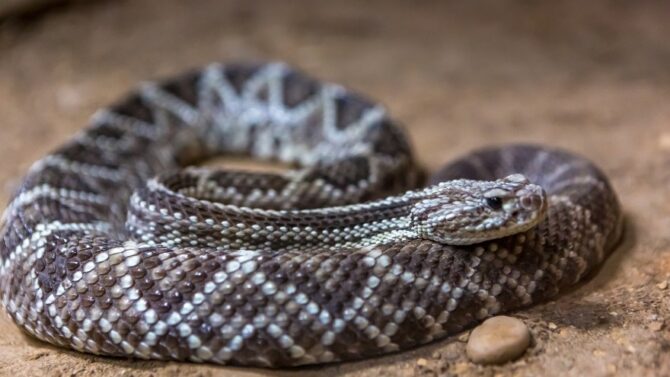Located in the Midwest of the United States lies the state of Indiana. The area is flat with a lot of farmed year-round farmland.
It is also referred to as “corn country.” it has gained a lot of reputation for its penchant for southern sensibilities, basketball, use of the word “ope,” and hosting the biggest motor racing spectacle.
Over 400 native and migratory bird species (including owls) have been identified in Indiana state.
There are eight species of owls in Indiana, including the barn owl, barred owl, eastern screech owl, great horned owl, long-eared owl, short-eared owl, northern saw-whet owl, and snowy owl.
All eight of Indiana’s owls are covered in this article, along with information on identifying them, how and when to see them. Let’s begin straight away!
Discover the Species of Owls In Indiana
1. Barred Owl
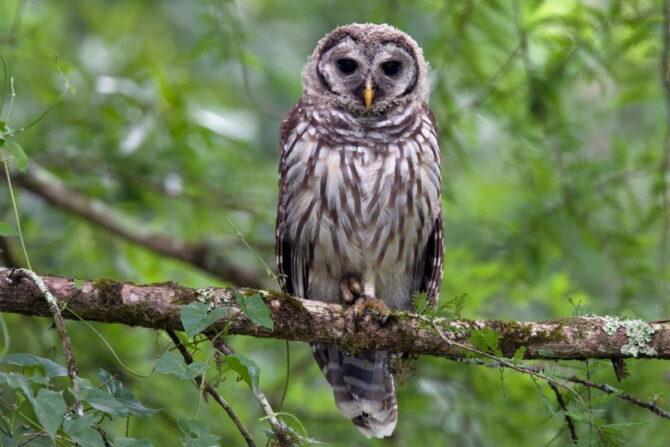
- Scientific Name: Strix varia
- Length: 12.6 – 15.8 inches (32 – 40 cm)
- Weight: 400 – 700 g (0.9 – 1.5 lbs)
- Wingspan: 99.1 – 114.3 cm ( 39 – 45 inches)
The term “Barred owl” refers to the brown and white barred patterns that this owl’s feathers create on its wings, which are also its most distinctive feature.
Barred owls are large gray-brown, white with round heads, dark brown eyes (like barn owls), a robust build, short, pointed, dull yellow beaks, and no ear tufts.
Swamp owls, striped owls, hoot owls, eight hooters, round-headed owls, and rain owls are other names for barred owls.
They can be spotted at any time of year and are widespread throughout the whole state of Indiana. Although they can be found throughout the state, the southeastern parts have had the most sightings.
Around nightfall, you can frequently see them flying low over the wetlands of the Limberlost Swamp in Geneva, Indiana.
Barred owls roost during the day and hunt at night, which is typical behavior for many owl species. They have a widely recognized call and are known to be highly vocal.
These owls are typically easier to locate by ear than sight, as with most owls. When someone calls, “who cooks for you? Who cooks for you all?” while in the woods, you can hear the barred owl’s unmistakable call.
Afterward, if you hear what seems to be insane laughing, that is typically two barred owls singing a duet for courtship.
2. Barn Owl
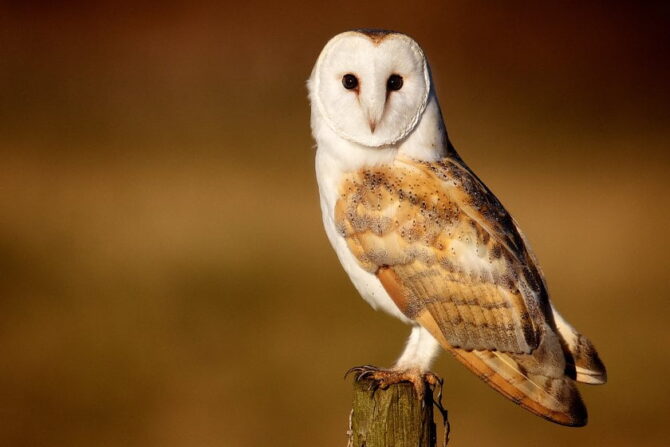
- Scientific Name: Tyto alba
- Length: 12.6 – 15.8 inches (32 – 40 cm)
- Weight: 400 – 700 g (0.9 – 1.5 lbs)
- Wingspan: 99.1 – 114.3 cm ( 39 – 45 inches)
The lovely yet elusive Barn owl is another owl that spends the entire year in Indiana. The barn owl’s stunning plumage and heart-shaped face make it simple to recognize.
Its name comes from the fact that it builds its nests in various man-made structures, including barns.
Barn owls have long, rounded wings and are medium in stature. They can appear entirely white in certain lighting conditions, but their backs and wings are clothed in buff and grey feathers.
Steeple owls, straw owls, monkey-faced owls, death owls, night owls, and other names are some of their alternate names.
Barn owls find the best-hunting grounds around field edges, watercourse margins, and grassy strips next to wooded areas.
Although they are year-round residents and can be observed throughout the state, they have been spotted most frequently in the southern region, where they are most active.
Like other owls, barn owls hunt for small mammals at night and can be seen doing so.
They are excellent night predators and are feared by anything known to be their prey because of their superb low-light vision and hearing.
More effectively than any other animal ever tested, they can locate and trap their prey solely by sound.
The barn owl doesn’t call very often, and when it does, it usually makes a long, rasping screech.
3. Eastern Screech Owl

- Scientific Name: Megascops asio
- Length: 6.3 – 9.8 inches (16 – 25 cm)
- Weight: 121 – 244 g (0.27 – 0.54 lbs)
- Wingspan: 18.9 – 24.0 inches (48 – 61 cm)
The Eastern screech owl is a large-headed owl with a thin neck. Its short, stocky body is coated in numerous hues of gray feathers, which enhances its ability to blend in with tree bark.
It also has tufts on its ears that point upward, giving it the appearance of an irate Leprechaun.
This owl is not overly picky about its habitat as long as there is enough dense cover in the form of wood.
The common screech owl, ghost owl, dusk owl, tiny-eared owl, red owl, cat owl, little horned owl, etc., are other names for eastern screech owls.
In appearance, these palm-sized owls resemble their slightly larger owl cousins, the Western screech owls.
They can be found in densely wooded areas, shady suburbs, urban parks, and other places.
In Indiana, these owls can be seen at any time of the year. They have been spotted throughout the state and are most active during the breeding season.
The eastern screech owl makes various sounds, including low, gentle hoots, loud, harsh barking calls that signal alarm or agitation, and screeches, generally made by adults protecting nests or fledglings.
Anger, especially when a bird is being swarmed, is indicated by a three- or four-note giggle or rattle.
4. Great Horned Owl
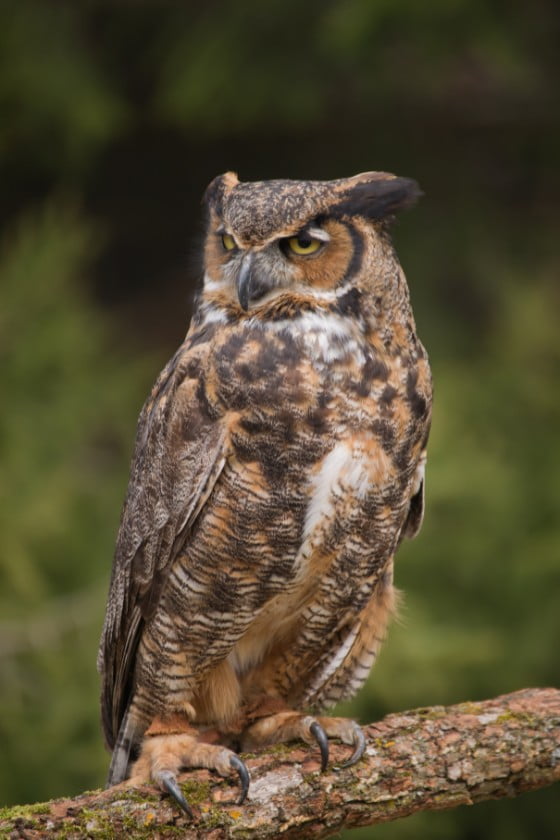
- Scientific Name: Bubo virginianus
- Length: 18.1 – 24.8 inches (46 – 63 cm)
- Weight: 910 – 2500 g (2.0 – 5.5 lbs)
- Wingspan: 39.8 – 57.1 inches (101 – 145 cm)
The Great horned owl is one of the biggest owls in Indiana, and it spends the full year in the state.
It is easily identified by its enormous size, ear tufts that resemble horns, hence its name, and extremely menacing yellow eyes with a cat-like appearance.
It is the only bird known to kill and eat skunks regularly. Red-tailed hawks are also known to be its sworn enemies.
The great horned owl is the largest owl species in Indiana and most of North America. The forests, deserts, wetlands, and grasslands of Indiana are home to these owl species.
They can also be seen in parks and cities, as well as in urban and suburban areas. As long as trees and rocky nesting locations are available, their habitat range is essentially limitless.
Great horned owls of both sexes hoot, but the males’ calls are lower in pitch than the females’.
At night, males make audible territorial calls that can be heard a few miles away. They announce their territory with stuttering, deep hoots that sound like this: hoo-h’HOO-hoo-hoo.
5. Long-Eared Owl
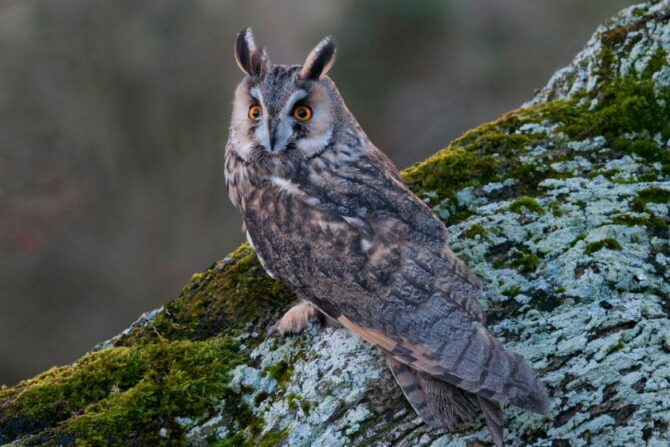
- Scientific Name: Asio otus
- Length: 13.8 – 15.8 inches (35 – 40 cm)
- Weight: 220 – 435 g (0.5 – 0.96 lbs)
- Wingspan: 35.4 – 39.4 inches (90 – 100 cm)
In Indiana, woods, open grasslands, and coniferous woodlands are all home to Long-eared owls, ferocious and silent hunters.
These owls have thick, dark feathers covering their bodies, and their faces are orange.
They are mostly heard rather than seen because of their coloring, which makes them difficult to spot in trees.
Long-eared owls get their name from their long tufts, like short-eared owls. Although they don’t resemble each other, they are frequently mistaken for great horned owls.
Long-eared owls are frequently referred to as “Lesser horned owls” because, among other things, they are significantly smaller than great-horned owls.
Additionally, compared to great horned owls, their ear tufts are significantly more closely spaced apart.
Over 200 sounds, including gentle, low hoots, high whistles, shrieks, barks, and meows that sound like cats, are produced by long-eared owls.
It’s impressive enough that a male’s call may be heard a staggering mile distant!
6. Northern Saw-Whet Owl

- Scientific Name: Aegolius acadicus
- Length: 7.1 – 8.3 inches (18 – 21 cm)
- Weight: 65 – 151 g (0.14 – 0.33 lbs)
- Wingspan: 16.5 – 18.9 inches (42 – 48 cm)
One of the considerably smaller owl species is the Northern saw-whet owl, which has observable wide orange eyes.
While their bellies are a bright white color, their wings and backs are covered in feathers that are a variety of colors and patterns of brown.
Although these owls can be found all over Indiana, they are most common in the state’s northern regions.
The saw-whet is not only the smallest owl found in Indiana but also one of the tiniest raptors in the country.
These tiny owls, which resemble American robins in size, got their name from the sound of their threatening call, akin to a saw being sharpened on a whetting stone.
They are typically very solitary birds that prefer to live in mature forests close to water sources, making them even more difficult to spot due to their extra-small size.1
They have mastered the art of camouflage, expertly blending into the background of trees. Saw-whets make squeaks, guttural noises, high-pitched tssst calls, whines, and barks.
They have a distinctive song called a too-too-too, a repetitive series of whistled notes delivered at a rate of roughly two notes per second and all roughly the same pitch.
7. Short-Eared Owl
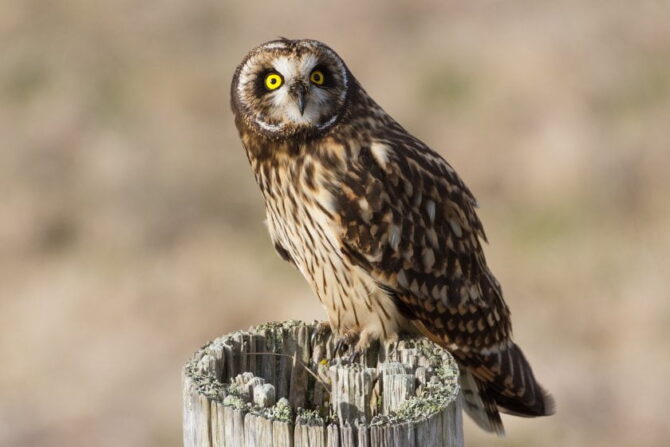
- Scientific Name: Asio flammeus
- Length: 13.4 – 16.9 inches (34 – 43 cm)
- Weight: 206 – 475 g (0.45 – 1.05 lbs)
- Wingspan: 33.5 – 40.5 inches (85 – 103 cm)
Indiana, the state’s northern region, is home to Short-eared owls all year long.
Short-eared owls are non-breeding in most of the state, so unless you reside in northern Indiana, search for them in winter in open fields and grasslands.
Short-eared owls get their name from the tiny, hardly perceptible “ear” tufts perched above their heads.
Their Latin name, flammeus, is derived from their flame-colored plumage of white, red, and brown. They have pale disk-shaped faces and large, yellow eyes with black rims.
They pursue prey close to the ground while hunting during the day, primarily around dawn and twilight.
There isn’t much vocalization among short-eared owls. But when they do make noise, these birds have an odd call that resembles a cat purring for a mate.
8. Snowy Owl
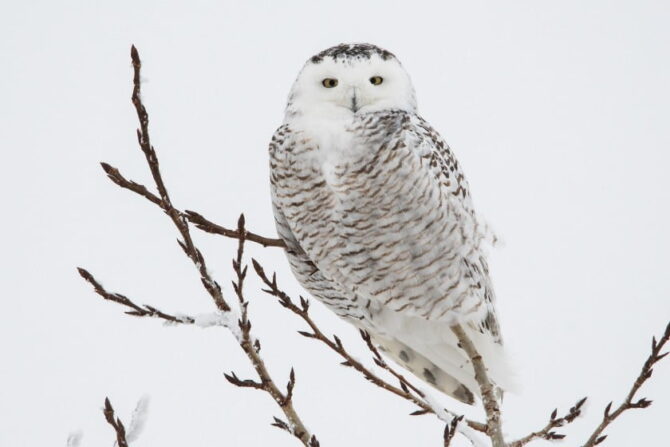
- Scientific Name: Bubo scandiacus
- Length: 20.5 – 27.9 inches (52 – 71 cm)
- Weight: 1600 – 2950 g (3.5 – 6.5 lbs)
- Wingspan: 49.6 – 57.1 in (126 – 145 cm)
The real owl family includes the big, white Snowy owl, often known as a Polar owl, an Arctic owl, or a Snowie.
Since they are the largest owls in Indiana and are comparable in size to great horned owls, they are also occasionally referred to as great white owls Look for them around the Lake Michigan shoreline, open agricultural terrain, airports, and other northernmost areas of Indiana.
They have white feathers and rounder heads without the ear tufts of other owls, so if you encounter one, you can be sure it’s not any other kind.
Despite their beauty, snowy owls are among the world’s most violent owls. Whether intentionally or not, they are known to dive-bomb anybody who enters their domain.
Males make low, strong, slightly rasping hoots, but both sexes do as well. These can be heard on the tundra for up to 7 kilometers, and other owls frequently respond with their hoots.
They are frequently given in pairs, although they can also come in groups of up to six.
What are the best bird watching spots in Indiana?
One of the many reasons someone might wish to travel to the wonderful state of Indiana is for the fantastic opportunities for bird viewing. Over 413 bird species may be found in Indiana, a stunning state where they can be viewed all year. Let’s look at some of Indiana’s top spots for birdwatching, where you may see some of the most stunning and fascinating bird species:
- Willow Slough State Fish and Wildlife Area
- Indiana Dunes State Park
- Salamonie Lake/Reservoir
- Patoka River National Wildlife Refuge
- Jasper-Pulaski State Fish and Wildlife Area
Other Related Questions
What is the most common owl in Indiana?
In all of Indiana, the barred owl is a common sight. These birds can be spotted all round the state, especially in the southern parts, at any time in the year.
What time of the year are owls most active?
Due to owls’ increased calling to attract mates or stake out territory in the late winter, this period is particularly excellent for owling.
Wrap-up
Owls are amazing animals that distinguish themselves from other bird species. As you must have read, every species has unique qualities that set it apart from the others.
Some owls are very simple to spot, like short-eared owls, while others, like barred owls and northern saw-whet owls, require expert knowledge and good fortune.
A diverse range of owl species calls Indiana’s forested environments, rivers, grassland plains, and lakeshores home.
The abundance of sites and activities in this Midwest state makes a trip there well worthwhile.
Next up…
- 15 Biggest Birds In The World (Largest Species + Pictures)
- 30 Beautiful Birds With Mohawks (With Pictures & Facts)
References & Notes
Facts Sources:
- Northern Saw-whet Owl Research. Indiana Audubon Society.




